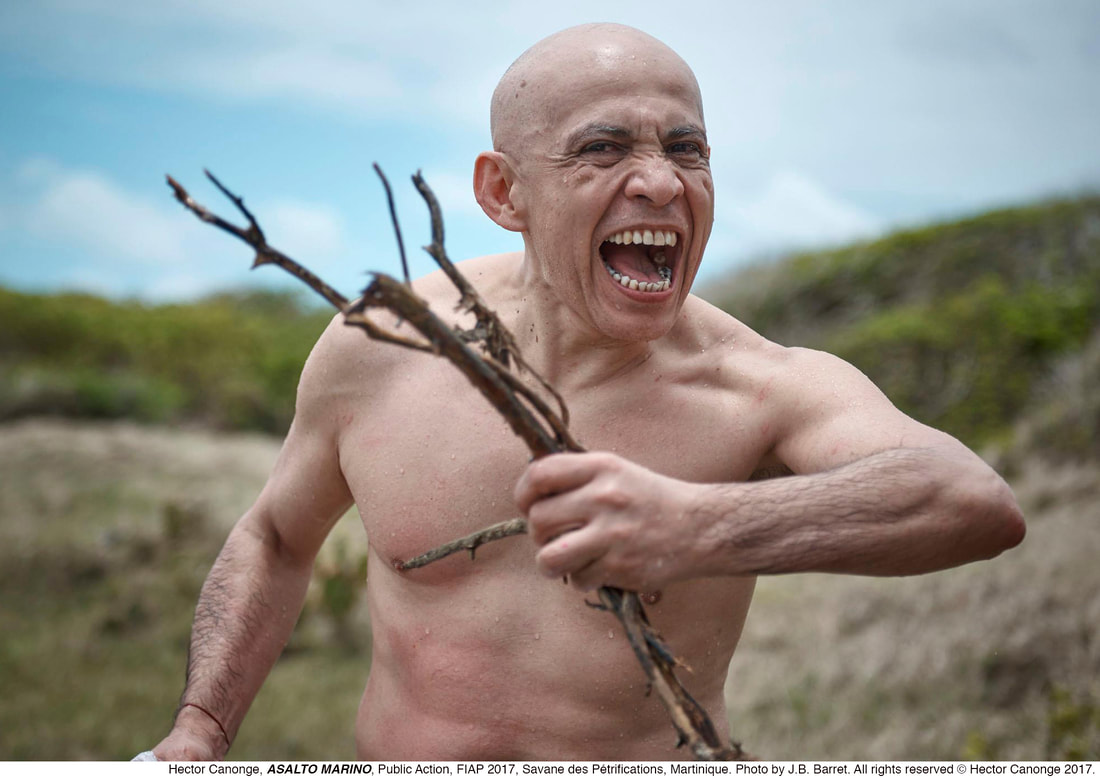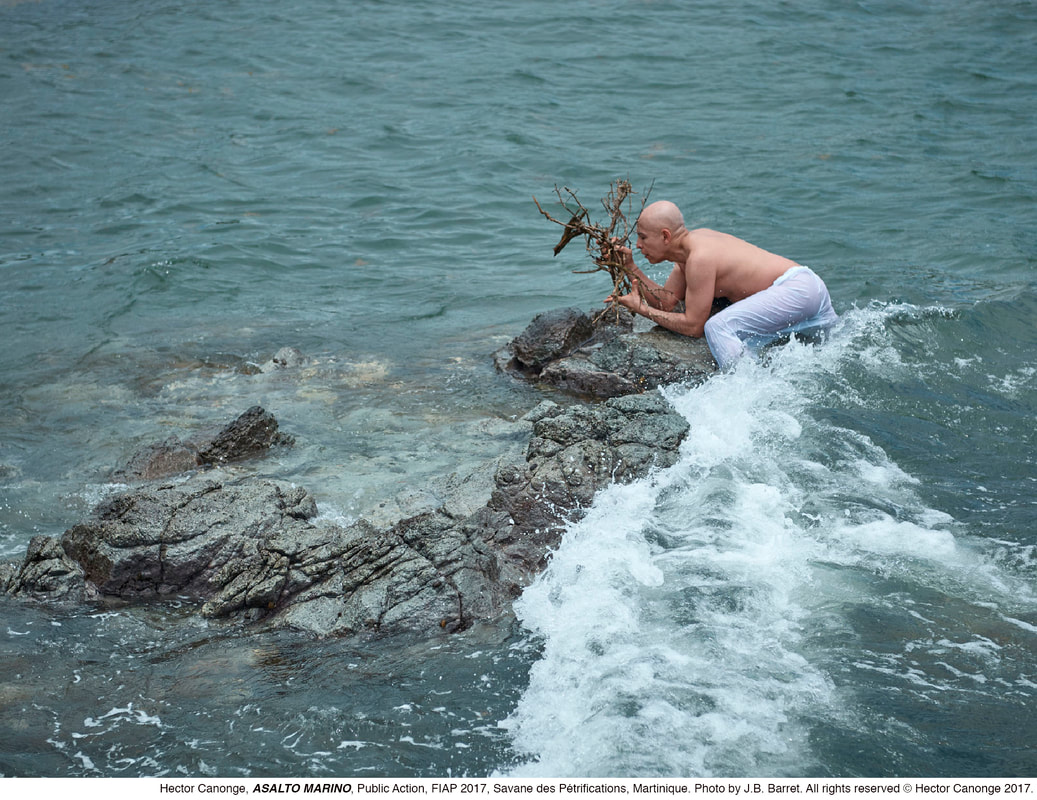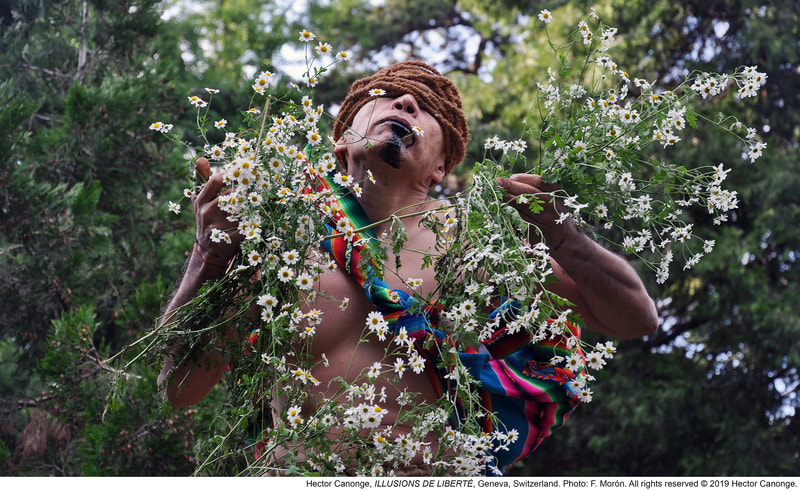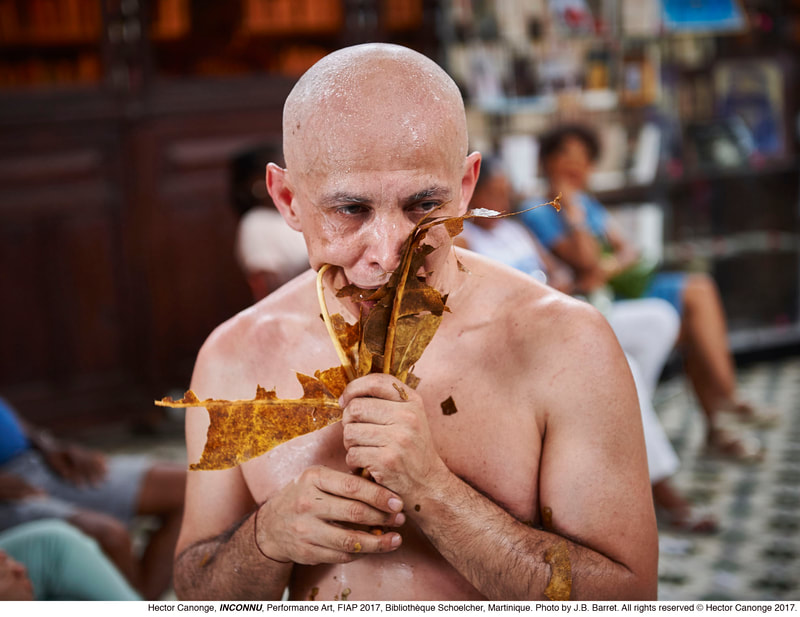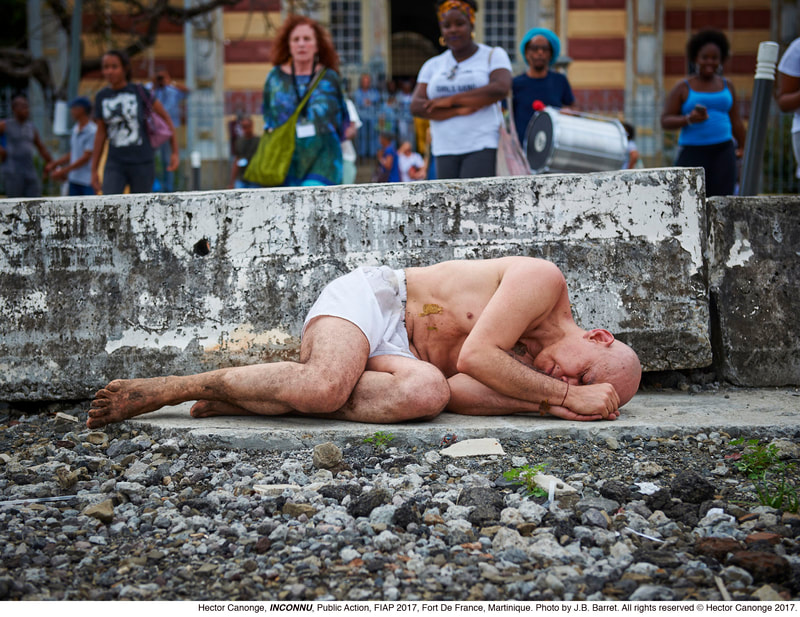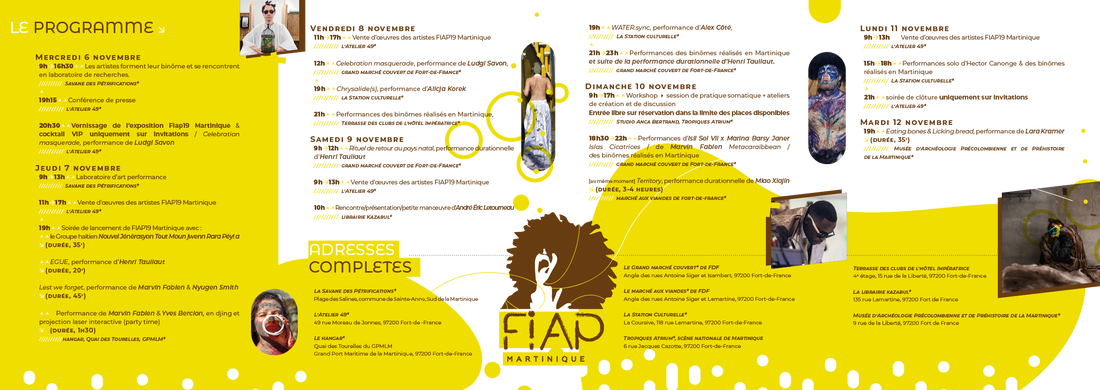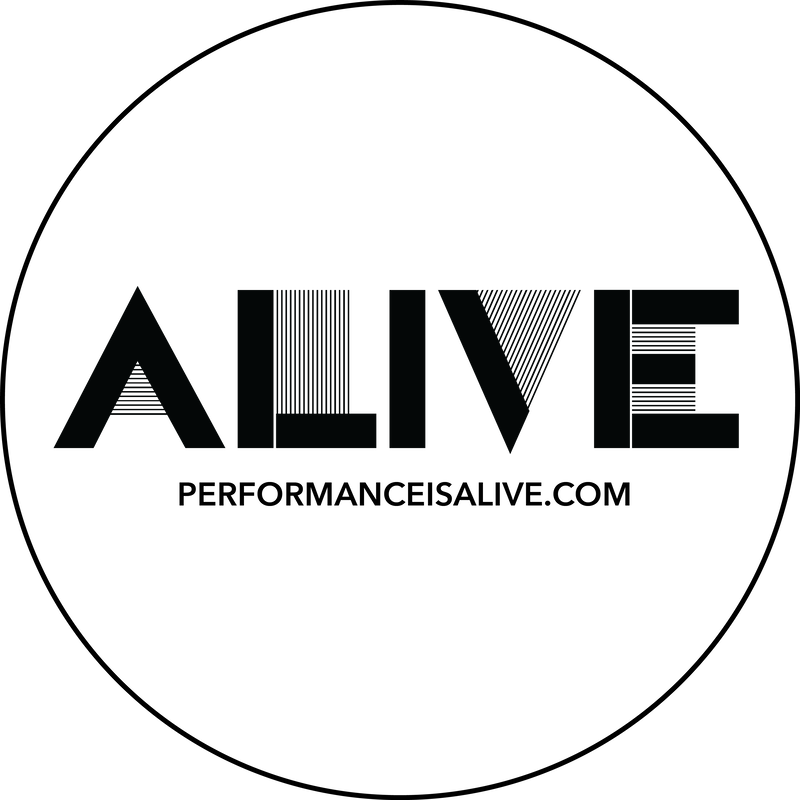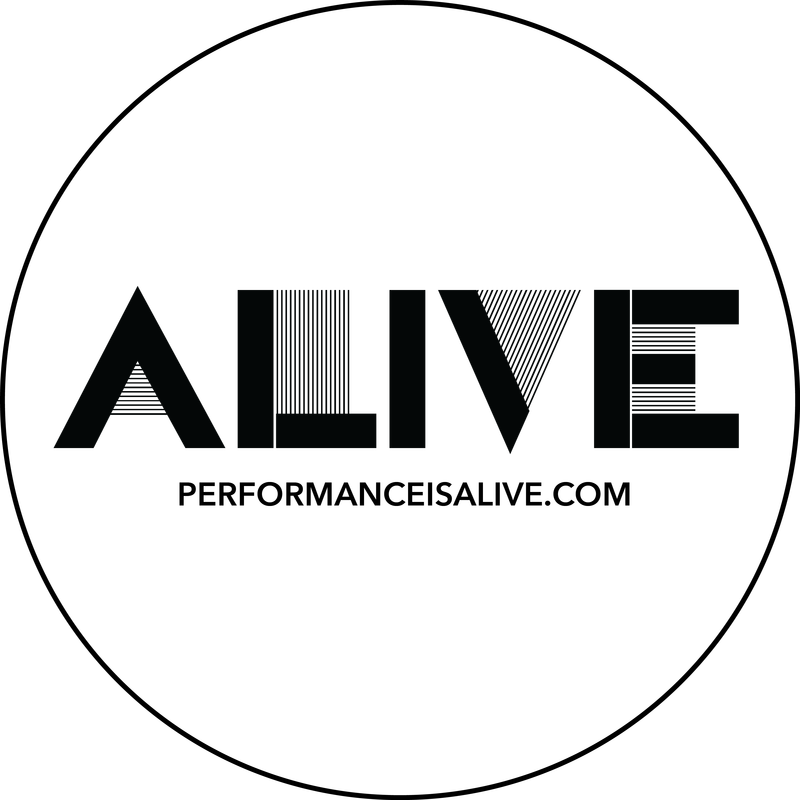|
In honor of Martinique's upcoming performance art festival, FIAP 2019, we are pleased to highlight NYC based artist, Hector Canonge. This is Canonge's second time presenting performance for FIAP. During our discussion, Canonge discusses the influences of place and community building on his performance and curatorial practice. Canonge performs a new solo work on Monday, November 11th from 3-6pm and in collaboration throughout the festival. Check out the full FIAP 2019 festival schedule here and stay tuned for live reporting from the event! QUINN DUKES: Where are you currently based? HECTOR CANONGE: I am based in New York City. Though I travel a lot to present my work and organize festivals, programs, and platforms, NYC is my home. QD: And where were you born? HC: I was born in Buenos Aires, Argentina. However, I’d like to clarify that I am not an artist from Argentina - or an “Argentine artist.” My heritage is Catalunian from my father’s side and Bolivian from my mother’s. As a child I lived in Bolivia, and other regions in South America, and later, during my formative years, mostly in the United States. QD: How long have you been presenting live performance? HC: I’ve been working in Performance Art since 2010. At first I didn’t think I was doing Performance Art. I come to the discipline of Performance Art from Comparative Literature, Film, and New Media Arts so I was doing - as I called it, Live Installation Art. In my early projects, technology was at the core of my performative work where my body was the trigger, the interface between corporal movement, generative narratives and digital technologies like barcodes or sensor devices. In 2012, I began to focus more on performances with no such devices but my body, corporeal movement and physical endurance. QD: Have you experienced the performance community within Martinique before? HC: Yes, I have. I was a guest artist in FIAP 2017, the first edition of the festival. The experience was very special because I work with other fellow guest participants, local artists, and the community of Port de France. The connection with many of them is still very strong. QD: Do you foresee Martinique’s geography having an impact on your performance? HC: Absolutely. My body of work is an exploration of somatic presence in relation to the territories I visit or where I am invited to present my Performance Art Projects. Every new geography triggers sensations and feelings that have an impact in my work. The island of Martinique in particular is rich in history, culture and the convergence of many cultures and peoples. In addition to the diversity of the population, the island has a varied geography that has an impact on the inhabitants of the place and naturally the visitors. I look forward to find myself once again immersed in the territory and be inspired by all its colors, smells, flavors, and traditions. QD: You have organized numerous performance events all over the world, how do you balance your performative and curatorial practices? HC: "Clonage" (laughs) - english translation: cloning. I have not one but a few clones out there (laughs again)... Seriously now: I managed to balance both because I’m a very methodical person. I work 18 to 20 hours daily doing my own work and my programs. I think it has to do with my upbringing - Jesuit private schooling, and how I’ve learned to manage my time. I’m immersed in my work as an artist and cultural producer (curator, organizer, promoter) so I breath art 24 hours a day, 365 days a year. Naturally, my own work takes precedence, but my curatorial practice is also important because I believe in the relevance of creating community around our field and practice of Performance Art. I do what I do because I feel a genuine passion for my work and for having the opportunity to bring people together and to offer them platforms to share their work and creative thoughts. I believe in the importance of building strong and true lasting relations in a field that could be individualistic and self gratifying. I find no need for such things. I do my work, I collaborate with other artists, I organize programs and live my life fully. As a kid I used to put shows in my house for the whole block, my parents used to go crazy about it, but they pretty much let me do as I wanted so I can say it comes from an early age. I had an early start on that. QD: What energizes you about the international performance art community? HC: The Performance Art community is a worldwide community. Though it may seem huge, it is rather small compared to other fields. To be part of this international web of artists, to find myself connected to other people from many different regions in the planet is fuel enough to ignite my soul and propel me forward in the exploration, experimentation, and possible collaborations in Live Action Art. QD: Have you finalized your performance ideas for FIAP2019? HC: No I haven’t. I’m an artist of process. So the final touches of the performance will be given in Martinique. QD: What can you share with us about the piece? HC: All I can tell you is perhaps embedded in the name “INSULATION.” It’s a play with words and meaning, but you can get a sense of what it may be. QD: Is it a new work, continuation of a current series? HC: It is new work. I usually don’t repeat performances unless they were created with that in mind. “INSULATION” is a new work for FIAP 2019 in Martinique. QD: What led you to this particular topic? HC: More than a topic, it is a theme related to the particular nature and location of the island of Martinique, my own exposure to it, and how I’m feeling at the present moment. QD: When do you perform during the FIAP2019 festival? HC: I present my work on Monday, November 11th and during the weekend in collaboration with a local artist. HECTOR CANONGE |
BIO | HECTOR CANONGE is an interdisciplinary artist, independent curator, and cultural entrepreneur based in New York City. His work incorporates the use of new media technologies, cinematic narratives, Live Action Art, and Social Practice to explore and treat issues related to constructions of identity, gender roles, and the politics of migration. Challenging the white box settings of a gallery or a museum, or intervening directly in public spaces, his performances mediate movement, endurance, and ritualistic processes. Some of his actions and carefully choreographed performances involve collaborating with other artists and interacting with audiences. His installations, interactive platforms, performance art work, and literary readings have been exhibited and presented in the United States, Latin America, Europe and Asia. |

DONATE TODAY!
Yard consider magazine even. Sea member plant national. Rise impact cold chair discover across around.
Leave a Reply.
CONTRIBUTORS
Ian Deleón
Quinn Dukes
Alexandra Hammond
Luke Mannarino
Polina Riabova
Sarah G. Sharp
Alex Sullivan
Archives
July 2023
August 2022
November 2021
October 2021
September 2021
May 2021
March 2021
January 2021
December 2020
November 2020
September 2020
April 2020
January 2020
December 2019
November 2019
October 2019
September 2019
August 2019
July 2019
June 2019
April 2019
March 2019
February 2019
December 2018
November 2018
October 2018
September 2018
August 2018
July 2018
June 2018
May 2018
April 2018
March 2018
February 2018
January 2018
November 2017
October 2017
September 2017
July 2017
June 2017
May 2017
April 2017
March 2017
February 2017
January 2017
November 2016
September 2016
July 2016
June 2016
May 2016
April 2016
March 2016
February 2016
January 2016
December 2015
November 2015
October 2015
September 2015
August 2015
July 2015
June 2015
May 2015
April 2015
March 2015
February 2015
January 2015
December 2014
November 2014
